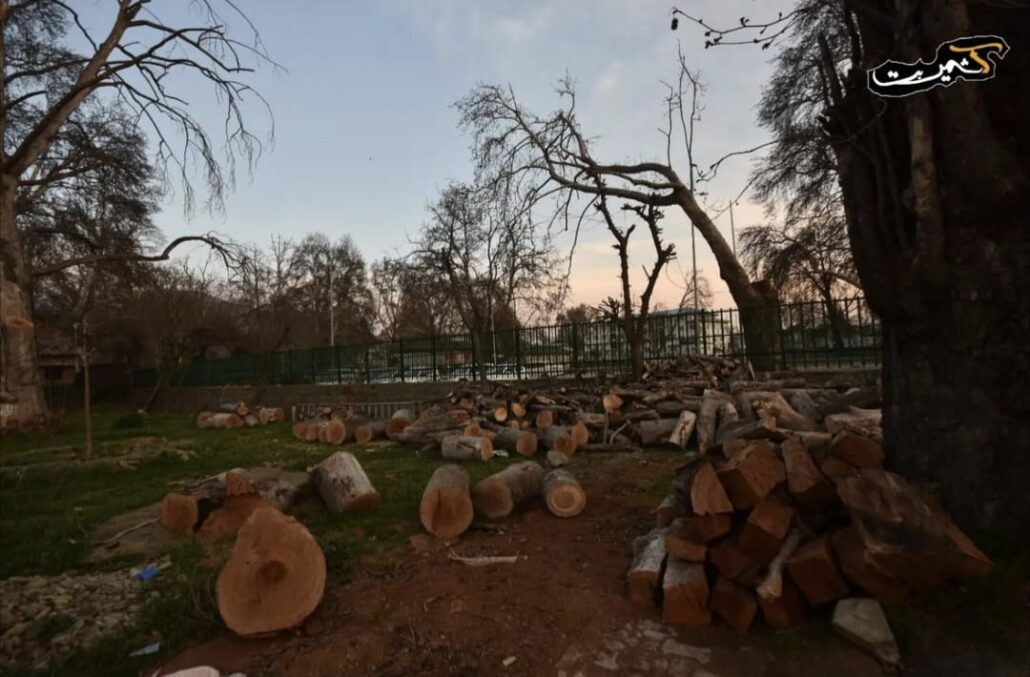
Bhat Yasir
Kashmir, long admired for its pristine natural beauty, is facing an environmental and public health crisis that is difficult to ignore. The cutting of trees has had dire consequences, not only for the region’s ecology but also for the health of its people.
Chronic respiratory diseases, asthma, heart attacks, and strokes are on the rise, yet the discussion around the connection between deforestation and health remains largely absent from public discourse.
The silence around these issues is especially profound in urban spaces, which have benefited from the expansion of infrastructure built at the expense of public health.
While urbanization in Kashmir is framed as progress, the resulting health crisis and environmental degradation remain unchecked, as the debate is confined to narrow political binaries that seldom address the root causes.
The Scale of Tree Cutting and Its Health Impacts
In the last several years, Kashmir has experienced massive deforestation. Between 2015 and 2022, official records show the loss of over 1,000 hectares of forest cover. However, local activists and environmentalists argue that the real extent of the loss is even greater, considering the widespread illegal logging and clearance of land for new roads and urban projects. In districts like Anantnag, Kupwara, Kulgam, Shopian, and Baramulla, entire hillsides have been stripped bare to make room for construction, leaving no buffer for the valley’s delicate ecosystem.
This loss of trees is directly linked to the sharp rise in health issues. Dr. Parvaiz Koul, Director of Sher-i-Kashmir Institute of Medical Sciences (SKIMS), explains, “Pollution is affecting every organ of our body. Srinagar city has the highest incidence of lung cancer in the country, and Jammu Kashmir has a high prevalence of lung diseases, and air pollution is a major risk factor for the ailments.” Experts attribute much of this to deforestation, noting that with fewer trees, the air cannot be purified naturally, leading to deteriorating health for the valley’s residents.
The rise in Chronic Obstructive Pulmonary Disease (COPD) is especially troubling. A recent report found that Kashmir now ranks among the top four Indian states with the highest rates of COPD, with 4,750 cases per 100,000 people.
According to the Indian Council of Medical Research (ICMR), air pollution is responsible for over 50% of respiratory diseases in the region, including asthma and Chronic Obstructive Pulmonary Disease (COPD).
The WHO has also attributed thousands of deaths globally to air pollution, and Kashmir’s situation mirrors this global trend.
A report released by ICMR estimated that air pollution in Jammu Kashmir is responsible for over 10,000 deaths annually due to respiratory and cardiovascular diseases, including conditions like asthma, COPD, strokes, and heart attacks.
Recent data from Kashmir indicates a concerning rise in respiratory and cardiovascular diseases, attributed to deteriorating air quality.
In 2024, the region recorded 8,355 new lung cancer cases, contributing to a five-year total of over 50,000 cases. Notably, Srinagar district reported the highest age-standardized incidence rate of lung cancer in India, with 19.34 cases per 100,000 males.
The Burden of Obstructive Lung Disease (BOLD) study found that about 16% of individuals aged 40 and above exhibit chronic airflow limitation, a precursor to COPD.
These statistics show the substantial burden of respiratory diseases in the region.
“In the past few years, we’ve seen a significant increase in asthma cases and respiratory distress, particularly during winter,” says Dr. Naveed Nazir Shah, a pulmonologist at Srinagar’s Chest Disease Hospital. “Air pollution is now a major contributor to these diseases, and it’s only going to get worse if we don’t address the root cause.”
Kashmir’s winter months, especially during the heavy snowfall, see a sharp increase in air pollution.
The high concentration of particulate matter (PM2.5) during winter months significantly deteriorates air quality, aggravating respiratory and cardiovascular diseases. This seasonal deterioration in air quality makes the situation worse, especially for vulnerable groups like children and the elderly.
The Silence of Urban Spaces and the Failure of Public Discourse
One of the most striking aspects of this crisis is the near-complete silence of urban centers. While the urban elite and policymakers continue to push for development, often at the expense of the environment, there has been little to no acknowledgment of the health consequences of deforestation. Srinagar, the largest urban center in the region, is rapidly expanding, with new roads, housing colonies, and infrastructure projects replacing once-green areas. Yet the issue of air quality and its effects on health rarely enters the public conversation.
As Dr. Shafaqat Khar, an environmental activist, puts it, “Urban Kashmiris talk about progress, but they fail to see that the very air they breathe is being polluted. The discourse in our cities has been reduced to political binaries, and environmental issues, like deforestation, are never seriously discussed. There’s a complete disconnect between urban development and environmental sustainability.”
Raymond Williams, a prominent socialist thinker, warned of the dangers of urban narratives that frame development solely in terms of growth and progress, often ignoring the ecological costs. “In cities like Srinagar, there’s a blind push for urbanization, and environmental issues are treated as secondary concerns,” says Khar. “This is a failure of urban spaces, and we must begin questioning this narrow view of development before it’s too late.”
The failure to engage in a meaningful debate about the environment is compounded by the fact that political leaders in Kashmir have not prioritized sustainability.
“The conversation around development in Kashmir is often reduced to one or two political questions. Environmental concerns are simply not a part of that debate,” says Abdul Rashid Khan, a former teacher turned environmental advocate from Shopian
“Until we start addressing the health impacts of deforestation, we’ll continue to see the people of Kashmir suffer.”
Global Research and the Link Between Tree Cutting and Health
Globally, there is a growing body of research connecting tree loss with increased health problems. A 2020 study published in The Lancet Planetary Health found that areas with higher levels of deforestation had significantly higher rates of asthma, cardiovascular diseases, and premature deaths. Similarly, the World Health Organization (WHO) has consistently emphasized the role of trees in improving air quality and reducing the risk of respiratory illnesses.
Trees act as natural filters for air pollutants, absorbing harmful gases and particles that would otherwise affect human health.
In the U.S., the US Forest Service conducted a study that showed how the loss of urban trees in 15 states led to an additional 15,000 deaths from cardiovascular and respiratory diseases over a 20-year period.
The study concluded that urban trees provide a wide range of health benefits, including reducing the incidence of asthma, improving mental health, and lowering the rates of cardiovascular diseases.
These global studies confirm what many Kashmiris have suspected for years: the loss of trees is directly linked to a decline in public health.
Forest Department Plantation Drives
In response to the growing deforestation crisis, the Jammu Kashmir Forest Department has launched several afforestation and plantation drives aimed at restoring lost greenery.
These efforts include planting thousands of saplings in the hope of replenishing some of the lost forest cover. While these drives have been seen as a positive step, experts argue that they cannot replace the ecological benefits of fully mature forests, which take decades to regenerate.
The Anantnag Forest Division has set a target of planting 2,13,000 trees this year, including conifers and broad-leaved species.
These saplings will be planted in designated forest closures, as well as in schools, colleges, and private institutions. The department will also distribute saplings to the public for plantation.
Divisional Forest Officer Anantnag, Mudasir Mehmood, in conversation with The Kashmiriyat said that an additional 70,000 trees of a specific species will be planted in the region due to their economic and ecological significance.
As Dr. Syed Munir, an environmental scientist based in Srinagar, notes, “Planting trees is essential, but it is not enough. We need to focus on preserving the existing forests as well. The long-term health of Kashmir’s population depends on the protection of these ecosystems.”
Despite these efforts, the challenges of reversing the damage caused by years of deforestation remain daunting. The forest department’s plantation drives have been marred by limited resources, delayed funding, and an absence of sustained political will to protect the remaining forests.
The felling of trees in Kashmir is not just an environmental issue—it is a matter of public health now.
As forests disappear, the air quality worsens, and respiratory and cardiovascular diseases rise. Local doctors and experts have warned that the health of the people is being compromised, but the public discourse has failed to address these concerns in a meaningful way.
Until the urban centers of Kashmir recognize their role in this crisis, and until there is a broader public debate about the environmental costs of urbanization, the health of the people will continue to suffer.




